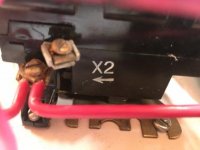DeSelle
Cast Iron
- Joined
- Oct 23, 2006
- Location
- Midlothian, TX
Hi all,
I’ve been working away on my RPC and I have a question about the wiring for the control circuit. I have scanned everything I can find and watched a bunch of videos but this is eluding me. The transformer I have is 240 to 120 and my coils are 120 so that is ok. The outputs on the transformer are X1 and X2. The coils both have 2 terminals. Both motor starters also have an X2 terminal and I read somewhere about connecting the X2 Contactor and transformer terminals to ground and then one side of each coil ( I have two contactors) to ground also then switching the X1 terminal to the other coils to control them. Is this correct? In testing it it works with just running the wires from the transformer to the coil and switching one but is that correct? Or should I be connecting (bonding?) the X2’s all together and to ground?
Thanks for any help as always,
I hope to wrap this up this weekend and post pics so you all can provide the much needed constructive criticism.....
Thanks,
Nathan
I’ve been working away on my RPC and I have a question about the wiring for the control circuit. I have scanned everything I can find and watched a bunch of videos but this is eluding me. The transformer I have is 240 to 120 and my coils are 120 so that is ok. The outputs on the transformer are X1 and X2. The coils both have 2 terminals. Both motor starters also have an X2 terminal and I read somewhere about connecting the X2 Contactor and transformer terminals to ground and then one side of each coil ( I have two contactors) to ground also then switching the X1 terminal to the other coils to control them. Is this correct? In testing it it works with just running the wires from the transformer to the coil and switching one but is that correct? Or should I be connecting (bonding?) the X2’s all together and to ground?
Thanks for any help as always,
I hope to wrap this up this weekend and post pics so you all can provide the much needed constructive criticism.....
Thanks,
Nathan








